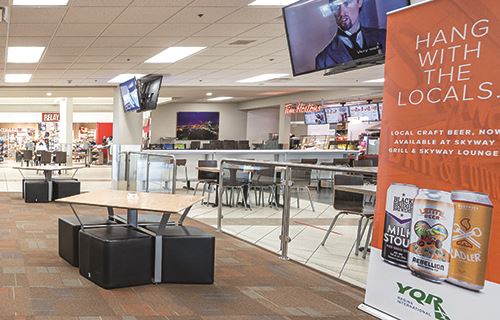Late last year, Regina International Airport (YQR) in Saskatchewan added a glass wall, and concessions sales promptly jumped. Liquor sales doubled, and post-security food receipts increased by more than 50%. By installing the new wall, the Canadian airport shifted the crucial dividing line between its pre- and post-security areas, and increased the volume and variety of food service options for passengers after they clear the screening checkpoint.
Late last year, Regina International Airport (YQR) in Saskatchewan added a glass wall, and concessions sales promptly jumped. Liquor sales doubled at the restaurant that moved from groundside to airside. And post-security food receipts increased by more than 50%.
By installing the new wall, the Canadian airport shifted the crucial dividing line between its pre- and post-security areas, and increased the volume and variety of food service options for passengers after they clear the screening checkpoint. The $1 million project (about $750,000 USD) was executed as a “half-step” measure until a more comprehensive project moves the security checkpoint from its current location on the second floor to the ground level.
Airport officials have put the next phase of plans on hold as they struggle to pay basic operating costs amid the COVID-19 downturn, but the new configuration created by the glass wall is helping in the meantime. (See Page 70 for more details about how the coronavirus pandemic is affecting YQR.)
|
facts&figures Project: Holdroom Renovations Location: Regina (SK) Int’l Airport Owner: Regina Airport Authority Cost: $1 million ($750,000 USD) Funding: Revenue from $20/ticket capital improvement fee Construction: July through Oct. 2019 Strategy: Add new wall so all 2nd floor concessions are in post-security areas; remove corridor to facilitate views of airfield in waiting areas Other Features: Children’s play area; improved Wi-Fi service Design: In-house Construction Manager: PCL Construction Management Interior Design: P3A Architectural Partnership Play Area: iPlayCO Furniture: Arconas; Trade West Impact: Liquor sales doubled & food sales increased more than 50% in the first 2 months after renovations |
James Bogusz, chief executive officer of the Regina Airport Authority, describes the recent holdroom renovations as a re-allocation of existing space that delivered a very big bang for the buck.
In addition to installing the new glass wall, YQR removed walls that formed an obsolete corridor serving international gates, added its first play area for children and upgraded internet service throughout the terminal.
The fall/winter 2019 project was funded with revenue from a $20 capital improvement fee added to each airline ticket.
Last year, YQR served 1.17 million passengers and ranked as Canada’s 15th busiest airport. Before COVID-19, it had anticipated serving 1.22 million in 2020.
Improving the Customer Experience
When Bogusz joined YQR’s executive team in 2017, he quickly set his sights on improving non-aeronautical revenue from 55% of the operating budget to 60% within five years. One of the first areas he focused on was increasing food sales because they lagged industry averages.
The problem was that the airport had only two concessionaires with full menus, Tim Hortons and Skyway Restaurant, and both were located before the security checkpoint. The post-security options, Tim Hortons Express, Skyway Lounge and Brioche Dorée, only offered beverages, snacks and light sandwiches.
After passengers cleared security, the options were too limited. “You could gaze at the food, but not buy it,” Bogusz recalls.
The concessions arrangement was a vestige of YQR’s last hold area renovation in 2008-09. “The thinking then was to have more restaurants pre-security to cater to the public-at-large,” Bogusz explains. “However, the trends have changed. You can’t take a Tim Hortons large Double-Double [coffee] through security. There is a low propensity to spend any time or money until after security.”
A 2018 survey of 1,500 passengers confirmed what Bogusz and other airport officials expected. The message from customers was loud and clear: Shift pre-security food options behind the checkpoint.
 Before recent changes, landside concessions occupied 65% of the available concessions space. By post-9/11standards, they should be just 25%, notes Bogusz. “The goal was to provide more options post-security without spending millions on renovations,” he explains.
Before recent changes, landside concessions occupied 65% of the available concessions space. By post-9/11standards, they should be just 25%, notes Bogusz. “The goal was to provide more options post-security without spending millions on renovations,” he explains.
Richard Toth, YQR’s manager of Project Planning and Development, notes that the airport had adequate square footage in the holdroom, but the space was so fragmented that it wasn’t conducive to creating a comfortable environment for passengers.
Facilitating access to concessions and removing the walls of a sterile corridor that was no longer needed due to current international boarding practices dramatically increased the utility of the second-level space.
“Removing the sterile corridor was a huge improvement in the flow and feel,” says Toth, noting that the new waiting area has open views to the airfield and much more natural light.
Removing the walls was the “easiest way to give the people what they wanted,” says Bogusz.
All in Good Time
Toth joined the YQR staff in 2017 just days before Bogusz, but he had worked on seven of the airport’s earlier renovations while with a local design firm. The holdroom project was one of his first assignments at YQR. Toth’s education in architecture allowed him to handle all the design work without assistance from an outside firm.
 “My perspective was the long-term game plan,” he relates, noting that the 2019 project was the first step of a total renovation of the second floor. “But we were not building throw-away elements,” Toth specifies. “Instead, we were preparing for the next phase.”
“My perspective was the long-term game plan,” he relates, noting that the 2019 project was the first step of a total renovation of the second floor. “But we were not building throw-away elements,” Toth specifies. “Instead, we were preparing for the next phase.”
The longer-term plan includes moving the screening checkpoint to the ground floor and possibly shifting restrooms, stairwells and elevator shafts.
As a small intermediate step between recent holdroom renovations and the checkpoint relocation, the airport plans to renovate restrooms and improve spaces currently occupied by Tim Hortons Express, Skyway Lounge, Brioche Dorée and Relay. One design goal is to open an exterior wall and provide passengers with better views of the Canadian Football League Roughriders stadium, which is just four miles away. One of the concepts under discussion is a sit-down restaurant with wait staff service.
The estimated price tag for the long-term renovation plan is $8 million.
Much More Than a Wall
The airport retained PCL Construction Management to execute the designs Toth developed for the holdroom renovations and to remodel Airport Authority offices and relocate an information technology facility. The office and IT projects began in 2018 and were completed by spring 2019. The design for the holdroom project was completed in 2019, and PCL began construction that July. Much of the initial work occurred behind temporary walls decorated with graphics of historic aircraft.
“We fast-tracked a lot of the product ordering so we could streamline the construction and minimize the downtime,” Toth notes.
Because of the tight timeline, construction crews often worked while the airport was open instead of only during off-hours. Grant Selinger, PCL’s senior project manager, notes that this required extra vigilance from onsite managers and crews. “We always knew the biggest risk was working alongside passengers in an operating airport,” says Selinger. “We had daily meetings with the airport authority and key foremen.”
Transitioning the worksite from pre- to post-security areas occurred at night, without customers present. The bulk of the work was completed by Oct. 31, 2019.
Previously, one waiting area served several flights at the same time. So the airport re-allocated a few gates during the renovation project to help spread out the passenger volume. “You can’t have all the people boarding comfortably when crammed into a tiny area,” Bogusz comments. “Now, with the gates spread out, it doesn’t feel crammed.”
The airport replaced nearly all of its traditional row seating with new and more varied options from Arconas and Trade West, a supplier based in Regina. Now, almost every seat has a USB port and electrical outlet. Most tables in the shared dining area are outfitted to power and charge electronics as well.
On a related note, the airport improved its Wi-Fi by increasing download speeds from 10 megabytes per second to 30 and tripling the number of access points in the terminal. “We tripled our Wi-Fi speed at no cost to the customers,” notes Justin Reves, YQR’s communications and commercial development manager.
Separate from the holdroom renovations and Wi-Fi improvements, YQR retained an interior design team from P3A Architectural Partnership in Regina to eventually rebrand the airport’s interior with new finishes. The colors and concepts P3A developed were used for the first time in the seating area and navigation paths throughout the renovated holdroom.

New Attraction for Kids
The play area installed during recent renovations caters to a wide range of ages.
Toth originally envisioned following an aviation or fossil theme, because the Regina region is popular for hunting dinosaur fossils. But little could be found from manufacturers beyond a few planes designed for toddlers, so the airport opted for a larger climbing structure with slides and tunnels.
“Most airports play areas are designed for 2- to 5-year-olds without much to entertain older kids,” he observes, noting that YQR’s new multi-level structure is sized and designed to appeal to older children as well.
Bogusz explains that the airport wanted an area where kids could burn off energy while their parents enjoyed a cup of coffee. “We did not scrimp on it,” he remarks. “We looked for the coolest one we could get in our budget.”
In the end, the airport went beyond its original budget of $20,000, which was based on earlier concepts, and spent $65,000 on an array that rivals the play areas found in fast-food chains. The 14-by-28-foot area was outfitted by iPlayCO, a firm based in British Columbia.
When YQR opened the play area just before last Christmas, its Facebook post elicited 1,400 likes, 231 comments and was shared 150 times. Reves and his staff estimate that the airport’s announcement reached at least 70,000 people.
Changes Pay Off, Then Everything Changed
In the first two months after renovations, liquor sales doubled and food sales grew more than 50%.
Originally, the project team expected that increased concessions revenue would “pay for” the cost of installing the new glass wall and other renovations in less than a year.
But then came COVID-19.
By April, YQR’s traffic was only 1.8% of April 2019.
“In May, there were 10 days we did not have a single commercial flight,” Bogusz laments. “In my wildest nightmares, I had never seen a terminal empty for an entire day with the exception of Sept. 11. It was unbelievable.”
By August, traffic rebounded to 19.2% of the previous August.
Typically, YQR averages about 25 flights a day. In September, it had seven daily flights.
With traffic off so dramatically, most concessions are closed or are operating with limited hours. The new play area is also closed.
The airport’s original game plan called for a variety of capital projects to unfold over the next five years—including more extensive renovation of the second floor.
“We had done a lot of planning as to what the next phases would be,” Toth reflects. “One week we were talking strategy, and the next week we were restructuring our whole operational budget for essential services.”
Putting it bluntly, YQR is struggling to stay afloat.
Bogusz says that YQR needs traffic levels to return to 70% to 80% of normal operations in order to break even. Near the end of the year, the airport will have depleted its operating cash reserves and will be forced to tap a line of credit to cover essential expenses, he elaborates.
Unlike U.S. airports and airlines, Canadian airports and airlines have not received special subsidies from their federal government. The only break airports received was an extension for rent payments to Transport Canada. “Airports here got nothing,” explains Bogusz. “No grants. No forgivable loans. Nothing.”
Despite the partial subsidies the Canadian government is providing to all businesses, YQR still had to lay off 35% of its staff. And the wage subsidies are scheduled to expire in December.
Toth was one of many who were furloughed at the end of April.
“My position is still there,” he says somewhat optimistically. “When I go back is conditioned on cash flow and traffic activity. There are too many moving pieces right now to get a clear picture.”

Pushing Through
As of early October, YQR was maintaining a basic level of essential services—ground support, firefighting and security—to keep the airfield open for cargo operations and general aviation traffic.
Its business took a big hit when the federal government closed the border with the U.S., and all other international traffic is now flowing through airports in Vancouver, Calgary, Toronto and Montreal. Essentially, YQR’s outbound traffic is now limited to domestic flights serving airports in Vancouver, Calgary and Toronto.
Bogusz senses cultural challenges on that front as well. “Although well-intentioned, travel restrictions and health advisories have dramatically reduced travel demand, with many potential passengers cancelling or delaying their plans,” he observes.
Despite all the unprecedented hurdles 2020 has presented, Bogusz remains determined to see YQR through it all and emerge stronger for it—stronger and with a more effective concessions program.



